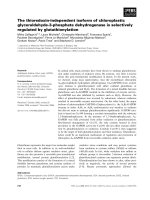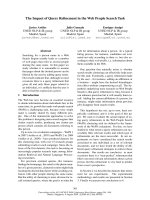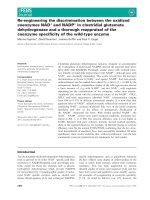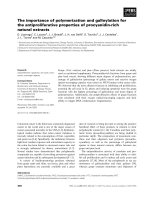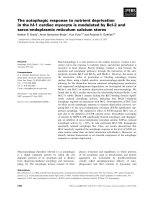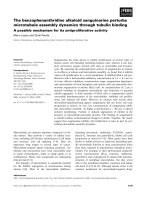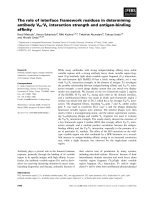Báo cáo khoa họcRe-engineering the discrimination between the oxidized coenzymes NAD+ and NADP+ in clostridial glutamate dehydrogenase and a thorough reappraisal of the coenzyme specificity of the wild-type enzyme docx
Bạn đang xem bản rút gọn của tài liệu. Xem và tải ngay bản đầy đủ của tài liệu tại đây (226.77 KB, 9 trang )
Re-engineering the discrimination between the oxidized
coenzymes NAD
+
and NADP
+
in clostridial glutamate
dehydrogenase and a thorough reappraisal of the
coenzyme specificity of the wild-type enzyme
Marina Capone*, David Scanlon, Joanna Griffin and Paul C. Engel
School of Biomolecular and Biomedical Science, Conway Institute, University College Dublin, Ireland
Introduction
The nicotinamide-nucleotide-dependent dehydrogenases
tend, in general, to be either NAD
+
-specific (and then
catabolic) or NADP(H)-specific (and accordingly ana-
bolic, except for those few enzymes such as glucose
6-phosphate dehydrogenase which provide NADPH
for biosynthesis) [1]. Crystallographic studies of arche-
typal NAD
+
-specific enzymes, such as alcohol and
lactate dehydrogenases [2,3], and archetypal NADPH-
specific dehydrogenases such as glutathione reductase
[4] have offered some degree of understanding of the
ways in which these enzymes achieve their coenzyme
specificity. This has been augmented by various
detailed studies of amino acid sequences [5,6], and has
been both tested and applied in some notably success-
ful examples of re-engineering of coenzyme specificity
[7–19]. As noted by Khouri et al. [17], however, the
Keywords
burst kinetics; coenzyme purity; coenzyme
specificity; glutamate dehydrogenase;
site-directed mutagenesis
Correspondence
P. C. Engel, School of Biomolecular and
Biomedical Science, Conway Institute,
University College Dublin, Belfield,
Dublin 4, Ireland
Fax: +353 1 716 6456
Tel: +353 1 716 6764
E-mail:
Present address
*Kuros Biosurgery AG, Zu
¨
rich, Switzerland
Program in Neurosciences & Mental
Health, Hospital for Sick Children, Toronto,
Canada
(Received 5 March 2011, revised 21 April
2011, accepted 9 May 2011)
doi:10.1111/j.1742-4658.2011.08172.x
Clostridial glutamate dehydrogenase mutants, designed to accommodate
the 2¢-phosphate of disfavoured NADPH, showed the expected large speci-
ficity shifts with NAD(P)H. Puzzlingly, similar assays with oxidized cofac-
tors initially revealed little improvement with NADP
+
, although rates with
NAD
+
were markedly diminished. This article reveals that the enzyme’s
discrimination in favour of NAD
+
and against NADP
+
had been greatly
underestimated and has indeed been abated by a factor of > 16 000 by the
mutagenesis. Initially, stopped-flow studies of the wild-type enzyme showed
a burst increase of A
340
with NADP
+
but not NAD
+
, with amplitude
depending on the concentration of the coenzyme, rather than enzyme.
Amplitude also varied with the commercial source of the NADP
+
. FPLC,
HPLC and mass spectrometry identified NAD
+
contamination ranging
from 0.04 to 0.37% in different commercial samples. It is now clear that
apparent rates of NADP
+
utilization mainly reflected the reduction of con-
taminating NAD
+
, creating an entirely false view of the initial coenzyme
specificity and also of the effects of mutagenesis. Purification of
the NADP
+
eliminated the burst. With freshly purified NADP
+
, the
NAD
+
: NADP
+
activity ratio under standard conditions, previously esti-
mated as 300 : 1, is 11 000. The catalytic efficiency ratio is even higher at
80 000. Retested with pure cofactor, mutants showed marked specificity
shifts in the expected direction, for example, 16 200 fold change in catalytic
efficiency ratio for the mutant F238S ⁄ P262S, confirming that the key struc-
tural determinants of specificity have been successfully identified. Of wider
significance, these results underline that, without purification, even the best
commercial coenzyme preparations are inadequate for such studies.
2460 FEBS Journal 278 (2011) 2460–2468 ª 2011 The Authors Journal compilation ª 2011 FEBS
lessons learned from previous attempts to modify
coenzyme specificity cannot be safely generalized to
other systems.
The terms NAD
+
- or NADPH-specific seem to
imply absolute discrimination between the closely simi-
lar coenzymes, but discrimination is never total, and
the actual factor varies widely from enzyme to
enzyme. Particularly interesting, however, are those
enzyme families that include members showing little
discrimination, so-called dual-specificity dehydrogenas-
es. The glutamate dehydrogenases are such a family
[20] and, as a result, have three different EC classifica-
tions,
EC 1.4.1.2, EC 1.4.1.3 and EC 1.4.1.4 for
NAD
+
-specific, dual-specific (particularly common in
higher animals and in Archaea), and NADP
+
-specific
members, respectively. Most of these are evolutionarily
and structurally related, in many cases quite closely,
despite the functional and classificational division
[21,22], and thus they provide a revealing example of
the way in which a single structural scaffold can be
adapted to produce remarkably different functional
outcomes.
Our own protein engineering experiments [23], based
on an analysis of the high-resolution structure of the
binary enzyme–NAD
+
complex of clostridial gluta-
mate dehydrogenase [24,25], were aimed initially at
facilitating productive binding of the phosphorylated
coenzyme by enlarging the potential binding pocket
and removing the negative charge, likely to repel the
2¢-phosphate of NADP(H), and replacing it with posi-
tive charge. Accordingly, mutants F238S, P262S and
F238S ⁄ P262S were created to provide more space, and
D263K to offer a more favourable electrostatic envi-
ronment. The kinetic behaviour of these mutant
enzymes with NADH and NADPH was compared at
different pH values [23], and, especially at the highest
pH examined (8), there were large changes in the dis-
crimination factor, so that, although none of the
mutants showed a complete reversal of specificity, the
last two of the four listed could reasonably be
described as dual-specific.
When, however, we turned to the opposite direction
of reaction, there was a perplexing difference in the
results, with seemingly remarkably little change in the
strong preference for NAD
+
over NADP
+
, estab-
lished as 300-fold under standard assay conditions by
Syed et al. [26]. In this article, we document these
surprising results and then analyse the source of the
discrepancy, with an outcome that not only necessi-
tates a revised view of clostridial glutamate dehydro-
genase and its specificity, but also has wider
significance for the study of coenzyme specificity in
other enzymes.
Results and Discussion
Initial kinetic analysis
The coenzyme specificity of the mutant enzymes was
initially assessed using the best available commercial
coenzymes without further purification. Values of k
cat
,
K
m
and k
cat
⁄ K
m
for the oxidized coenzymes are pre-
sented in Table 1. After replacement of Phe238 by
serine, NAD
+
was less effective as a coenzyme because
of moderate decreases in k
cat
(36, 14 and 33% at
pH 6.0, 7.0 and 8.0, respectively) and marked increases
in apparent K
m
( 10 fold at pH 6.0 and 7.0, 14 fold at
pH 8.0). NAD
+
is evidently bound very poorly to this
mutant. However, surprisingly, no improvement was
apparent with NADP
+
as the coenzyme. At pH 7.0
and 8.0, approximately five-fold decreases in k
cat
, and
increases of approximately four- and six-fold respec-
tively for K
m
(Table 1), appeared to indicate markedly
lower overall catalytic efficiency with this coenzyme.
The single proline to serine mutation at position 262
likewise decreased the overall catalytic efficiency with
both oxidized coenzymes. Using NAD
+
, this mutant
had values comparable with wild-type for k
cat
, particu-
larly at pH 7.0 and 8.0 (Table 1). Decreases in cata-
lytic efficiency were due to increases in K
m
,
approximately nine-fold at pH 7.0 and seven-fold at
pH 8.0. For NADP
+
, the decrease in overall catalytic
efficiency reflected decreases in k
cat
of almost three-fold
at pH 8.0, with accompanying increases in K
m
, approx-
imately five-fold at pH 7.0 and three-fold at pH 8.0
(Table 1). Correspondingly, this mutation seemed to
offer no significant shift in specificity towards
NADP
+
.
Turning to the third of the single mutants, D263K,
once again, there appeared to be a decrease in catalytic
efficiency with both NAD
+
and NADP
+
as coen-
zymes, though less marked than for the other muta-
tions, and at pH 8.0 with NADP
+
as coenzyme there
was little difference between the performance of the
wild-type and mutant enzymes (Table 1).
The results for these three mutants were extremely
puzzling; the mutations had been designed to facilitate
binding of the phosphorylated coenzyme, and with the
reduced coenzymes [23] there were indeed large shifts,
as expected, in the discrimination factor, 150 fold and
272 fold, respectively, for example, for P262S and
D263K at pH 8.0. In this study, only the double-
mutant F238S ⁄ P262S gave a result reasonably close to
expectation with the oxidized coenzymes (Table 1): at
both pH 7.0 and pH 8.0 the large discrimination factor
in favour of NAD
+
decreased to only 3–4 for this
mutant. Even in this case, however, the apparent
M. Capone et al. Coenzyme preference in glutamate dehydrogenase
FEBS Journal 278 (2011) 2460–2468 ª 2011 The Authors Journal compilation ª 2011 FEBS 2461
improvement was entirely due to a large decrease in
catalytic efficiency with NAD
+
rather than an increase
with NADP
+
. In fact, there was a deterioration of
10 fold in the catalytic efficiency with NADP
+
.
Thus here also, the results were in contrast to those
for the reduced coenzymes [23], which, at pH 7.0 and
8.0, showed large increases in catalytic efficiency with
NADPH, over 100-fold at pH 8.0.
Rapid-reaction studies
The possibility that different rate-limiting steps in the
two reaction directions might account for the strikingly
different outcomes of the mutagenesis with reduced
[23] and oxidized coenzymes (above) prompted an
investigation of presteady-state kinetics. Burst kinetics
detects rapid accumulation of product before the
steady state is reached: the presence or absence of a
burst provides information on the position of the rate-
limiting step along the reaction pathway, and the
amplitude of the burst should be proportional to the
enzyme concentration. A ‘burst’ increase in A
340
was
detected in the first few milliseconds of reaction with
NADP
+
as coenzyme, but not with NAD
+
. Two dif-
ferent phases were identified in the stopped-flow traces:
the first phase (Fig. 1A inset) consisted of the rapid
single exponential burst in A
340
, reaching an apparent
plateau within a few seconds. The small differences in
the height of this plateau for different concentrations
of enzyme (5–20 lm) are due to shifts in the baseline
as a result of the contribution of the enzyme itself to
A
340
; after correction for this baseline shift (Fig. 1B),
the burst amplitude was entirely independent of the
enzyme concentration. Over much longer periods
(Fig. 1A, main panel), the apparent plateau was
revealed as a very slow and initially linear second
phase of increase in absorbance, finally leading to the
expected reaction equilibrium in over 4 h.
Further analysis showed that the burst amplitude with
NADP
+
was dependent on the concentration of the
coenzyme itself, and not only on its concentration, but
also the commercial source. With 1 mm NADP
+
from
Roche Diagnostics Ltd. (Burgess Hill, UK), the burst
amplitude corresponded to 3.1 lm reduced coenzyme,
i.e. 0.31% of the NADP
+
used. Similarly, a burst of
1.2 lm newly formed reduced coenzyme, was observed
for NADP
+
from Apollo Scientific (Stockport, UK),
corresponding to 0.12% of the total NADP
+
.
Analysis and purification of NADP
+
The rapid-reaction results strongly suggested that the
burst might be due to trace impurities in the coenzyme.
Direct HPLC analysis of the same NADP
+
batches
(Fig. 2) revealed trace contamination. Despite the com-
plexity of the chromatograms, the injection of NADP
+
Table 1. Initial comparison of kinetic parameters between wild-type glutamate dehydrogenase, F238S, P262S, F238S ⁄ P262S and D263K
mutant enzymes. To determine kinetic parameters for NAD ⁄ P
+
, glutamate concentration was kept constant (40 mM) over a range of
NAD ⁄ P
+
concentrations (0.01–1 mM) under standard assay conditions. All experiments were repeated in triplicate and the kinetic parameters
and their standard errors (± SE) were calculated by a nonlinear regression method [36] with
ENZPACK version 3.0 (Biosoft Ltd, Cambridge,
UK). The discrimination factor in the right-hand column, a measure of the preference for NAD
+
over NADP
+
, is calculated as the ratio of the
catalytic efficiency, k
cat
⁄ K
m
, for NAD
+
to that for NADP
+
. ND, not determined.
pH
NAD
+
NADP
+
Discrimination
factor
k
cat
(s
)1
) K
m
(mM)
k
cat
⁄ K
m
(s
)1
ÆmM
)1
) k
cat
(s
)1
) K
m
(mM)
k
cat
⁄ K
m
(s
)1
ÆmM
)1
)
Wild-type 6.0 3.88 ± 0.09 0.10 ± 0.02 38.8 0.13 ± 0.05 0.58 ± 0.01 0.224 173
F238S 6.0 1.41 ± 0.02 1.00 ± 0.05 1.41 0.07 ND ND
P262S 6.0 0.51 ± 0.02 0.314 ± 0.034 1.63 ND ND
F238S ⁄ P262S 6.0 ND ND ND
D263K 6.0 1.92 ± 0.07 0.18 ± 0.02 10.7 0.09 ND ND
Wild-type 7.0 20.4 ± 0.7 0.114 ± 0.012 179 0.57 ± 0.06 0.26 ± 0.01 2.19 81.7
F238S 7.0 17.6 ± 0.3 1.25 ± 0.46 14.1 0.125 ± 0.04 1.1 ± 0.7 0.113 125
P262S 7.0 23.0 ± 1.4 1.04 ± 0.13 23.0 0.457 ± 0.05 1.23 ± 0.22 0.371 62
F238S ⁄ P262S 7.0 3.31 ± 0.47 2.22 ± 0.21 1.49 0.242 ± 0.05 0.632 ± 0.27 0.382 3.9
D263K 7.0 12.6 ± 0.21 0.17 ± 0.02 72.4 0.40 ± 0.05 0.380 ± 0.002 1.05 69
Wild-type 8.0 51.6 ± 0.6 0.127 ± 0 .012 482 0.909 ± 0.19 0.336 ± 0.015 2.70 179
F238S 8.0 39.8 ± 1.7 1.83 ± 0.04 21.7 0.270 ± 0.05 2.04 ± 0.08 0.132 164
P262S 8.0 53.4 ± 2.6 0.90 ± .11 59.3 0.339 ± 0.06 1.04 ± 0.30 0.339 175
F238S ⁄ P262S 8.0 4.49 ± 0.34 6.28 ± 0.34 0.71 0.513 ± 0.193 2.24 ± 0.77 0.229 3.1
D263K 8.0 39.3 ± 1.9 0.376 ± 0.03 104 0.958 ± 0.05 0.336 ± 0.05 2.85 36.5
Coenzyme preference in glutamate dehydrogenase M. Capone et al.
2462 FEBS Journal 278 (2011) 2460–2468 ª 2011 The Authors Journal compilation ª 2011 FEBS
enriched with NAD
+
permitted identification of a peak
of the latter estimated at 0.37% in NADP
+
from
Roche, 0.15% in NADP
+
from Apollo Scientific and
0.04% in NADP
+
from Sigma-Aldrich Ireland Ltd.
(Dublin, Ireland). The agreement of the rapid reaction
kinetics with the HPLC analysis suggested nearly total
conversion of NAD
+
into NADH in the reaction
observed. From the equilibrium constant for the oxida-
tive deamination of l-glutamate [27] it can be estimated
that, under the conditions used, 97–98% of the con-
taminant NAD
+
should be converted into NADH.
These results strongly suggest that NAD
+
is the con-
taminant affecting the course of the enzymatic assays.
Stopped-flow experiment repeated with purified
NADP
+
When the rapid-reaction experiment was repeated
under identical conditions but using NADP
+
from
Apollo Scientific freshly purified in our laboratory, the
absence of the ‘burst’ (Fig. 3) confirmed that this phe-
nomenon was due to the impurities in the commercial
coenzyme. In addition, when commercial NADP
+
was
used without purification for the steady-state kinetics,
an inhibitory effect of the NADH formed in the first
part of the reaction was observed on the following
phase of the reaction with NADP
+
. This effect was
confirmed by enriching the mixture with varying
amounts of NADH (results not shown). The binding
of the reduced coenzymes to the active site of clostrid-
ial glutamate dehydrogenase is much tighter than the
binding of the oxidized coenzyme. Together with the
initial preference for the nonphosphorylated coenzyme,
this explains the potent inhibitory effect of such a
small NADH contamination.
Mass spectrometric identification of NAD
+
peak
Isolation and mass spectroscopic analysis confirmed
the identity of the contaminant. Comparison with the
spectrum of an authentic NAD
+
sample revealed
total similarity of the fragmentation pattern. The neg-
ative portion of the spectrum displayed a fragment at
m ⁄ z 540, along with a small amount of parental mol-
ecule (m ⁄ z 662.1). The signal at m ⁄ z 540 corresponds
to the ADP-ribose moiety of the coenzyme resulting
from splitting off the nicotinamide ring, suggesting
that the covalent bond between the nicotinamide and
the ribose of the coenzyme is particularly labile. The
signal of the parental molecule is also visible at
m ⁄ z 664.1 in the positive spectrum; the nicotinamide
ring, counterpart fragment of the ADP-ribose
(m ⁄ z 540) gives a signal at m ⁄ z 123.1, whereas ade-
nine is registered at m ⁄ z 136.1.
In view of these findings, the possibility of the
reverse contamination was also tested. However, the
0
0.2
0.4
0.6
0.8
1
1.2
0 50 100 150 200 250 300
A
340 nm
A
340 nm
Time (min)
0.000
0.005
0.010
0.015
0.020
0.025
0.030
0.035
0.040
0.4 0.6 0.8 1.0 1.2 1.4 1.6 1.8 2.0 2.2
[enzyme] (μM)
A
B
Fig. 1. Time course of the reaction of wild-type clostridial gluta-
mate dehydrogenase with NADP
+
. (A) The main panel shows the
reaction of 15 l
M glutamate dehydrogenase with 1 mM coenzyme
and 40 m
ML-glutamate (concentrations after mixing) monitored at
340 nm over 250 min. The increase in absorbance was linear for
the first 30–40 min; on this basis, the value for the specific activity
was calculated as 1.84 nmolÆmin
)1
Æmg
)1
, rate 0.0015 s
)1
. The inset
shows stopped-flow traces observed over the first few seconds of
the forward reaction of 2.5 l
M (lowest trace), 5 lM, 7.5 lM, 10 lM
and 15 lM (highest trace) wild-type clostridial glutamate dehydroge-
nase with 1 m
M NADP
+
and 40 mML-glutamate (all concentrations
after mixing). A burst phase was detected in all cases. The almost
horizontal trace seen in each case after 2–3 s corresponds to the
slow, steady-state reaction monitored in the main panel. (B) Cor-
rection applied to the burst amplitudes calculated at different
enzyme concentrations in (A). The increase of enzyme concentra-
tion causes a significant baseline shift at 340 nm. A reference zero
baseline was first recorded by mixing 2 m
M NADP
+
and 80 mML-
glutamate with buffer in the stopped-flow; a set of individual base-
lines was recorded by mixing different enzyme concentrations with
buffer (d); finally, 2 m
M NADP
+
and 80 mML-glutamate were
mixed with different enzyme concentrations, and the burst ampli-
tudes were recorded (s). The baseline recorded for each enzyme
concentration (d) was subtracted from the corresponding value
recorded for the burst amplitude (s), giving the final plot (.)
showing no dependence of the burst amplitude on the enzyme
concentration.
M. Capone et al. Coenzyme preference in glutamate dehydrogenase
FEBS Journal 278 (2011) 2460–2468 ª 2011 The Authors Journal compilation ª 2011 FEBS 2463
contamination of NAD
+
by NADP
+
reported by
some other authors [28] was not observed in our
batches of NAD
+
.
Reassessment of coenzyme specificity of
clostridial glutamate dehydrogenase
In light of the discovery of variable contamination of
the commercial NADP
+
samples by the preferred coen-
zyme NAD
+
, it was necessary to reconsider the steady-
state results. First of all, the specific activity of clostrid-
ial glutamate dehydrogenase under standard assay con-
ditions (1 mm coenzyme, 40 mml-glutamate, 0.1 m
phosphate, pH 7.0) was re-determined with freshly
purified NADP
+
and using three different methods of
measurement, absorbance measurements in the stopped-
flow apparatus, conventional spectrophotometry and
fluorimetry. These three methods, respectively, yielded
values of 2.22, 2.33 and 2.78 · 10
)3
lmolÆmin
)1
Æmg
)1
(mean = 2.44 · 10
)3
lmolÆmin
)1
Æmg
)1
). This figure is
11 000 times lower than the corresponding figure for
the preferred coenzyme NAD
+
. This remarkable dis-
crimination factor is nearly 40 times higher than the
300-fold factor reported by Syed et al. [26]. It is now
also very clear how such a large overestimation of the
rate with NADP
+
can arise. If we assume the use of a
commercial NADP
+
containing 0.3% NAD
+
, as in the
case of the Roche sample used in this study, then in a
steady-state assay, as in the rapid-reaction study, the
contaminating NAD
+
will be used first. There will not
be simple proportionality because the 1 mm NAD
+
in a
standard assay is well above K
m
and the 0.3% NAD
+
contamination in 1 mm NADP
+
is far below K
m
.
Nevertheless, a rate 1 ⁄ 200 of the rate in a standard
NAD
+
reaction may be anticipated.
A detailed re-analysis of the steady-state properties
of wild-type glutamate dehydrogenase with freshly
purified NADP
+
was therefore carried out. The values
for K
m
and k
cat
given in Table 1 are 0.26 ± 0.01 mm
and 0.57 ± 0.06 s
)1
, respectively. The redetermination
with pure coenzyme gave a much higher value for the
K
m
of 3.2 ± 0.4 mm, 30-fold higher than the K
m
for NAD
+
. Moreover, k
cat
was calculated as
8.2 · 10
)3
±6· 10
)4
s
)1
, 2500 fold lower than the
figure for NAD
+
and also 70 times lower than the
value obtained with unpurified coenzyme. On this
basis, a new ratio of the specificity constants for the
oxidized coenzymes can be calculated: this ‘discrimina-
tion factor’ reveals that wild-type clostridial glutamate
dehydrogenase is 80 000-fold more active with
NAD
+
than with NADP
+
. This factor was previously
estimated as 82 at pH 7.0 (Table 1), 1000 times less
Time (min)
a.u.
Fig. 2. Overlap of HPLC elution profiles of
NADP
+
batches from different suppliers.
The four traces show the impurity peaks in
25–30 ng samples of commercial NADP
+
(black, Roche; green, Apollo Scientific; blue,
Sigma; cyan, Apollo enriched with NAD
+
).
The last sample allowed unambiguous iden-
tification of the peak of NAD
+
in the other
chromatograms (indicated by the arrow).
The amounts of contaminant NAD
+
present
in the samples were calculated by peak
integration using the
MILLENNIUM software
package.
Fig. 3. Superposition of stopped-flow burst-kinetic traces for wild-
type clostridial glutamate dehydrogenase and different batches of
NADP
+
at identical concentrations. (Upper) Reaction with Grade I
NADP
+
from Roche. (Middle) Reaction with NADP
+
from Apollo
Scientific. (Lower) Reaction with freshly purified NADP
+
.
Coenzyme preference in glutamate dehydrogenase M. Capone et al.
2464 FEBS Journal 278 (2011) 2460–2468 ª 2011 The Authors Journal compilation ª 2011 FEBS
than the true value, underlining the impact of quite a
small level of contamination on these results.
Reassessment of the effects of the mutations on
coenzyme specificity
In view of the dramatically altered figure for the strin-
gency of coenzyme specificity in clostridial glutamate
dehydrogenase, it now also becomes clear that the ini-
tial assessment of the effects of the mutagenesis on the
relative activities with NAD
+
and NADP
+
is very
likely to be misleading. As a preliminary test of this,
kinetic parameters were redetermined using freshly
purified NADP
+
at pH 7.0 for two mutants, F238S
which had appeared to give deterioration rather than
improvement with NADP
+
, and the double-mutant
which showed a 21-fold improvement from a discrimi-
nation ratio of 82 to one of 3.9. The data in Table 2
show a remarkable change in this assessment. For the
wild-type enzyme with NADP
+
, the true values for
k
cat
are very much lower and those for K
m
much
higher than previously estimated with the commercial
coenzyme. As a result, the discrimination factor for
the wild-type enzyme is underestimated by 1000-
fold. F238S, therefore, offers a 161-fold improvement
instead of a 1.5-fold deterioration in discrimination
factor. Even more dramatically, the modest apparent
21-fold improvement in the double-mutant should be a
16 200-fold improvement, entirely vindicating the ini-
tial thinking behind the mutagenesis.
Wider implications
Careful purification of nicotinamide coenzymes has
been recognized in the past as an important issue in
the study of dehydrogenases [29]: coenzymes were
often purified in research laboratories prior to use
[30,31] in order to avoid misleading kinetic anomalies,
but this routine has largely been abandoned in recent
years because the purity and stability of the best
commercial preparations have dramatically improved.
Although concern and worry persist over the purity of
reduced coenzymes, which are often contaminated by
the oxidized form, Grade I NAD
+
and NADP
+
are
generally utilized without further purification, even in
enzymatic studies of coenzyme specificity [7,32,33]. In
our own laboratory, because analytical HPLC only
revealed what we took to be trace, negligible contami-
nation, well below 0.5%, we have frequently proceeded
without further purification of the coenzyme. Other
authors, using sensitive detection with a dehydrogenase
coupled with the reduction of INT to a coloured for-
mazan, have recently reported the presence of 0.1%
NAD
+
in NADP
+
from different suppliers [34,35].
Woodyer et al. [28] also mentioned coenzyme contami-
nation in the context of coenzyme specificity studies of
the NAD
+
-dependent phosphite dehydrogenase from
Pseudomonas stutzeri: these authors analysed NAD
+
and NADP
+
from Sigma (purity grade not reported)
by HPLC, finding no contamination of NADP
+
by
NAD
+
within the detection limits of HPLC. The
authors, however, point out the presence of 2%
NADP
+
in the NAD
+
: this was claimed not to intro-
duce a bias in their kinetic measurements, and there-
fore NAD
+
was utilized without further purification.
In this study, the extremely large effect of 0.3%
contamination of the NADP
+
by the favoured coen-
zyme NAD
+
is directly attributable to the very high
level of discrimination between the two coenzymes, so
that the 0.3% NAD
+
produces a rate far higher than
that for the 99.7% NADP
+
. Accordingly, with the
mutants, all those in which the discrimination has not
been largely abolished give grossly misleading results;
only the double-mutant, which approaches dual speci-
ficity status, gives a result remotely approaching the
truth, because in this situation the 0.3% contamination
is at last less dominant.
It may be argued that this problem is exceptional,
deriving from an extraordinarily high discrimination
factor of 80 000. However, because we ourselves
assumed until this study that clostridial glutamate
dehydrogenase, although NAD
+
specific, showed a far
Table 2. Summary of corrected kinetic parameters for the oxidative deamination. Values of K
m
and k
cat
for NADP
+
were redetermined by
utilizing freshly purified NADP
+
in the enzymatic assays, and are displayed in the table. Discrimination factors are calculated as the ratio
k
cat
⁄ K
m
NAD
+
⁄ k
cat
⁄ K
m
NADP
+
.
Enzyme
NAD
+
NADP
+
Discrimination
factorK
m
(mM) k
cat
(s
)1
)
k
cat
⁄ K
m
(s
)1
ÆmM
)1
) K
m
(mM) k
cat
(s
)1
)
k
cat
⁄ K
m
(s
)1
ÆmM
)1
)
Wild-type 0.11 ± 0.01 22.7 ± 0.5 206 3.2 ± 0.4 8.2 E
)3
±6E
)4
0.0026 79 200
F238S 2.21 ± 0.46 19.5 ± 1.9 8.83 1.65 ± 0.11 0.030 ± 0.001 0.018 491
F238S ⁄ P262S 22 ± 3 10.0 ± 0.8 0.45 3.1 ± 0.3 0.283 ± 1.3 E
)2
0.091 4.9
M. Capone et al. Coenzyme preference in glutamate dehydrogenase
FEBS Journal 278 (2011) 2460–2468 ª 2011 The Authors Journal compilation ª 2011 FEBS 2465
lower level of discrimination, one must wonder how
many other examples remain undiscovered of dehydro-
genases that are more specific than reported and of
protein engineering experiments more successful than
the experimenters think. We have carried out a wider
programme of mutagenesis at several other positions
in the coenzyme binding site and it is clear that all
NADP
+
kinetics will have to be reassessed with
freshly purified coenzyme.
Experimental procedures
Enzymes and substrates
The methods for purifying the wild-type glutamate dehy-
drogenase and the four mutants from transformed cultures
of Escherichia coli have been described in detail elsewhere
[22,23,26].
l-Glutamate monosodium salt (99–100%), ammonium
chloride (99.5%) and 2-oxoglutarate (97%, 2.3% water) of
analytical grade were purchased from Sigma. NAD
+
lithium
salt grade I ( 100%) was obtained from Roche. Different
batches of NADP
+
were: NADP
+
disodium salt ( 98%),
from Roche; NADP
+
monosodium salt 97%, from
Sigma; NADP
+
monosodium salt > 98%, from Apollo
Scientific Ltd. All solutions of the above compounds were
freshly prepared in 100 mm phosphate buffer at pH 7.0, and
used in enzymatic assays within a few hours. Coenzyme
solutions were kept cold and their concentrations deter-
mined by measuring A
260
(e
NAD ðPÞþ
=18· 10
)3
m
)1
Æcm
)1
).
Examination of coenzyme specificity
Kinetic parameters k
cat
and K
m
were obtained by measur-
ing initial rates of reaction for the mutant and wild-type
enzymes in 0.1 m potassium phosphate (pH 6.0, 7.0 and
8.0) with varying concentrations of coenzyme (0.01–2 mm),
and l-glutamate fixed at a high concentration (40 mm).
Activity was usually measured with a Kontron Uvikon 941
or Cary 50 recording spectrophotometer, thermostatted at
25 °C, by recording changes in A
340
, but in some cases, for
greater sensitivity, initial-rate measurements were carried
out with a Hitachi F-4500 fluorescence spectrophotometer
(Hitachi High-Tech, Tokyo, Japan). A standard curve of
the change in fluorescence versus [NAD(P)H] (0.1–1.9 lm)
was prepared and enzyme activity was determined by mea-
suring the production of NAD(P)H within the linear range.
Rapid reaction kinetics
An Applied Photophysics SX18.MV-R stopped-flow appa-
ratus with a dead-time of 1.3 ms was used for presteady-
state kinetic measurements. A 1 mm optical pathlength in a
20 lL cell was used for absorbance measurements at
340 nm; monochromator slit widths were set at 10 nm. The
indicated concentrations are final values after mixing, unless
stated otherwise. Where possible, l-glutamate, 2-oxogluta-
rate and ammonium chloride were used at near-saturating
concentrations (40, 20 and 100 mm respectively), as in the
steady-state analysis, and at lower concentrations where the
reaction in the above conditions was difficult to observe.
Coenzyme concentrations were kept at or above K
m
values
derived by steady-state analysis. A minimum of 5 lm
enzyme was used for the assays.
NADP
+
purification
Coenzymes were analysed with a Waters Controller 600
HPLC system on a reverse-phase column (SUPELCOSIL
LC-18-T, particle size 5 lm, 25 · 4.6 cm). The samples
were dissolved in 100 mm KH
2
PO
4
and 25–30 ng of each
was injected. The elution protocol was as advised by the
column manufacturers (Elution Protocol for nucleotides,
Supelco Catalogue). Solutions were adjusted to pH 6.0 to
prevent damage to the silica solid phase. Data were
acquired with a Waters Photodiode Array Detector 996
and chromatograms were monitored at 254 nm.
Where indicated, NADP
+
was purified on a preparative
scale (up to 9 mg) using a BioCAD Perseptive System FPLC
apparatus with a POROS 20 HQ column (4.60 · 100 mm), a
flow rate of 5 mLÆmin
)1
and monitoring at 260 and 280 nm.
Elution was as follows: 10 mm NaCl isocratic for 10 column
volumes; 30 mm NaCl step change and then isocratic for 10
column volumes; gradient increasing to 300 mm NaCl over
50 column volumes. All solutions were double-filtered
through 0.2 lm filters before use.
Fractions of 2 mL containing NADP
+
were collected
and concentrated by rotary evaporation at 30 °Ctoa
volume suitable for gel filtration. NaCl was separated from
the concentrated coenzyme solution [30] on a column
(2 · 30 cm) of Bio-Gel P2 Fine (45–90 lm wet, Bio-Rad
Laboratories, Hercules, CA, USA) at 4 °C. Samples of up
to 20 mg NADP
+
were applied in a volume not exceeding
2.2 mL, and MilliQ-grade water was used for elution, fol-
lowed at 254 nm with a BioRad Econo UV Monitor. Des-
alting was checked by conductivity measurements on each
fraction. The purified NADP
+
solution was stored at
)20 °C and used within 2–3 days of the purification.
Impurity peaks from commercial preparations of
NADP
+
were analysed on a mass spectrometer Quattro
microÔ (Waters Micromass, Manchester, UK) equipped
with electrospray source.
Acknowledgements
MC was supported by a postgraduate scholarship from
the Irish Council for Science, Engineering and Tech-
nology. DS was supported through a Basic Science
Coenzyme preference in glutamate dehydrogenase M. Capone et al.
2466 FEBS Journal 278 (2011) 2460–2468 ª 2011 The Authors Journal compilation ª 2011 FEBS
research grant (SC2002 ⁄ 0502) to PCE from Enterprise
Ireland. PCE was supported during the writing of this
paper by a Fellowship grant (05 ⁄ FE1 ⁄ B857) from Sci-
ence Foundation Ireland. These sources of financial
support are gratefully acknowledged. We are also
grateful to Dr Dilip Rai of the School of Chemistry
and Chemical Biology at UCD who ran the mass spec-
trometric analysis of coenzyme samples and purified
contaminants.
References
1 Lehninger AL, Nelson DL & Cox MM (1993)
Principles of Biochemistry, 2nd edn, pp. 390–392.
Worth, New York.
2 Bra
¨
nde
´
n CI, Jo
¨
rnvall H, Eklund H & Furugren B
(1975) Alcohol dehydrogenases. In The Enzymes,
Vol. XI (Boyer PD, ed.), pp. 103–190. Academic Press,
New York.
3 Holbrook JJ, Liljas A, Steindel SJ & Rossmann MG
(1975) Lactate dehydrogenase. In The Enzymes,
Vol. XI (Boyer PD, ed.), pp. 121–292. Academic Press,
New York.
4 Thieme R, Pai EF, Schirmer RH & Schulz GE (1982)
Three-dimensional structure of glutathione reductase at
2A
˚
resolution. J Mol Biol 152, 763–782.
5 Hanukoglu I & Gutfinger T (1989) cDNA sequence of
adrenodoxin reductase. Identification of NADP binding
sites in oxidoreductases. Eur J Biochem 180, 479–484.
6 Wierenga RK, Terpstra P & Hol WGJ (1986) Predic-
tion of the occurrence of the ADP-binding bab-fold in
proteins, using an amino acid sequence fingerprint.
J Mol Biol 187, 101–107.
7 Scrutton NS, Berry A & Perham RN (1990) Redesign
of the coenzyme specificity of a dehydrogenase by pro-
tein engineering. Nature 343, 38–43.
8 Bocanegra JA, Scrutton NS & Perham RN (1993) Crea-
tion of an NADP-dependent pyruvate dehydrogenase
multienzyme complex by protein engineering. Biochem-
istry 32, 2737–2740.
9 Chen R, Greer A & Dean AM (1995) A highly active
decarboxylating dehydrogenase with rationally inverted
coenzyme specificity. Proc Natl Acad Sci U S A 92,
11666–11670.
10 Yaoi T, Miyazaki K, Oshima T, Komukai Y & Go M
(1996) Conversion of the coenzyme specificity of isoci-
trate dehydrogenase by module replacement. J Biochem
119, 1014–1018.
11 Steen IH, Lien T, Madsen MS & Birkeland NK (2002)
Identification of cofactor discrimination sites in NAD-
isocitrate dehydrogenase from Pyrococcus furiosus. Arch
Microbiol 178, 297–300.
12 Zhang L, Ahvazi B, Szittner R, Vrielink A & Meighen
E (1999) Change of nucleotide specificity and enhance-
ment of catalytic efficiency in single point mutants of
Vibrio harveyi aldehyde dehydrogenase. Biochemistry
38, 11440–11447.
13 Chen R, Greer A & Dean AM (1996) Redesigning sec-
ondary structure to invert coenzyme specificity in iso-
propylmalate dehydrogenase from
Saccharomyces cerevisiae. Proc Natl Acad Sci U S A 93,
12171–12176.
14 Holmberg N, Ryde U & Buelow L (1999) Redesign of
the coenzyme specificity in l-lactate dehydrogenase
from Bacillus stearothermophilus using site-directed
mutagenesis and media engineering. Protein Eng 12
,
851–856.
15 Watanabe S, Kodaki T & Makino K (2005) Complete
reversal of coenzyme specificity of xylitol dehydrogenase
and increase of thermostability by the introduction of
structural zinc. J Biol Chem 280, 10340–10349.
16 Ehrensberg AH, Elling RA & Wilson DK (2006) Struc-
ture-guided engineering of xylitol dehydrogenase cosub-
strate specificity. Structure 14, 567–575.
17 Khouri AG, Fazelinia H, Chin JW, Pantazes RJ, Cirino
PC & Maranas CD (2009) Computational design of
Candida boidinii xylose reductase for altered cofactor
specificity. Protein Sci 18, 2125–2138.
18 Petschacher B, Leitgeb S, Kavanagh KL, Wilson DK &
Nidetzky B (2005) The coenzyme specificity of
Candida tenuis xylose reductase (AKR2B5) explored by
site-directed mutagenesis and X-ray crystallography.
Biochem J 385, 75–83.
19 Banta S, Swanson BA, Wu S, Jarnagin A & Anderson
S (2002) Alteration of the specificity of the cofactor-
binding pocket of Corynebacterium 2,5-diketo-d-glu-
conic acid reductase A. Protein Eng 15, 131–140.
20 Smith EL, Austen BM, Blumenthal KM & Nyc JF
(1975) Glutamate dehydrogenases. In The Enzymes,
Vol. XI (Boyer PD, ed.), pp. 293–367. Academic Press,
New York.
21 Lilley KS, Baker PJ, Britton KL, Stillman TJ, Brown
PE, Moir AJ, Engel PC & Rice DW (1991) The partial
amino acid sequence of the NAD
+
-dependent gluta-
mate dehydrogenase of Clostridium symbiosum: implica-
tions for the evolution and structural basis of coenzyme
specificity. Biochim Biophys Acta 1080, 191–197.
22 Teller JK, Smith RJ, McPherson MJ, Engel PC &
Guest JR (1992) The glutamate dehydrogenase gene of
Clostridium symbiosum – cloning by polymerase chain
reaction, sequence analysis and over-expression in
E. coli. Eur J Biochem 206, 151–159.
23 Griffin J & Engel PC (2011) An examination by site-
directed mutagenesis of putative key residues in the
determination of coenzyme specificity in clostridial
NAD
+
-dependent glutamate dehydrogenase. Enzyme
Res, in press.
24 Baker PJ, Britton KL, Engel PC, Farrants GW, Lilley
KS, Rice DW & Stillman TJ (1992) Subunit assembly
M. Capone et al. Coenzyme preference in glutamate dehydrogenase
FEBS Journal 278 (2011) 2460–2468 ª 2011 The Authors Journal compilation ª 2011 FEBS 2467
and active site location in the structure of glutamate
dehydrogenase. Proteins 12, 75–86.
25 Baker PJ, Britton KL, Rice DW, Rob A & Stillman TJ
(1992) Structural consequences of sequence patterns in
the fingerprint region of the nucleotide binding fold.
Implications for nucleotide specificity. J Mol Biol 228,
662–671.
26 Syed SE-H, Engel PC & Parker DM (1991) Functional
studies of a glutamate dehydrogenase with known
three-dimensional structure: steady-state kinetics of
the forward and reverse reactions catalysed by the
NAD
+
-dependent glutamate dehydrogenase of
Clostridium symbiosum. Biochim Biophys Acta 1115,
123–130.
27 Engel PC & Dalziel K (1967) The equilibrium constants
of the glutamate dehydrogenase system. Biochem J 105,
691–695.
28 Woodyer R, van der Donk WA & Zhao H (2003)
Relaxing the nicotinamide cofactor specificity of phos-
phate dehydrogenase by rational design. Biochemistry
42, 11604–11614.
29 Dalziel K (1963) Kinetic studies of liver alcohol dehy-
drogenase and pH effects with coenzyme preparations
of high purity. J Biol Chem 238, 1538–1543.
30 Dickinson FM & Engel PC (1977) The preparation of
salt-free nicotinamide coenzymes. Anal Biochem 82,
523–531.
31 Dalziel K & Dickinson FM (1966) Purification of nicotin-
amide adenine dinucleotide. In Biochemical Preparations,
Vol. XI (Maehly AC, ed.), pp. 84–88. Wiley, New York.
32 Feeney R, Clarke AR & Holbrook JJ (1990) A single
amino acid substitution in lactate dehydrogenase
improves the catalytic efficiency with an alternative
coenzyme. Biochem Biophys Res Commun 166, 667–672.
33 Nishiyama M, Birktoft JJ & Beppu T (1993) Alteration
of coenzyme specificity of malate dehydrogenase from
Thermus flavus by site-directed mutagenesis. J Biol
Chem 268, 4656–4660.
34 Valero E, Varo
´
n R & Garcı
´
a-Carmona F (1995) Kinetic
study of an enzymic cycling system coupled to an enzy-
mic step: determination of alkaline phosphatase activity.
Biochem J 309, 181–185.
35 Inouye K, Ueno I, Yokoyama S & Sakaki T (2002)
Development of a synchronous enzyme-reaction system
for a sensitive enzyme immunoassay. J Biochem 131,
97–105.
36 Wilkinson GN (1961) Statistical estimations in enzyme
kinetics. Biochem J 80, 324–332.
Coenzyme preference in glutamate dehydrogenase M. Capone et al.
2468 FEBS Journal 278 (2011) 2460–2468 ª 2011 The Authors Journal compilation ª 2011 FEBS
